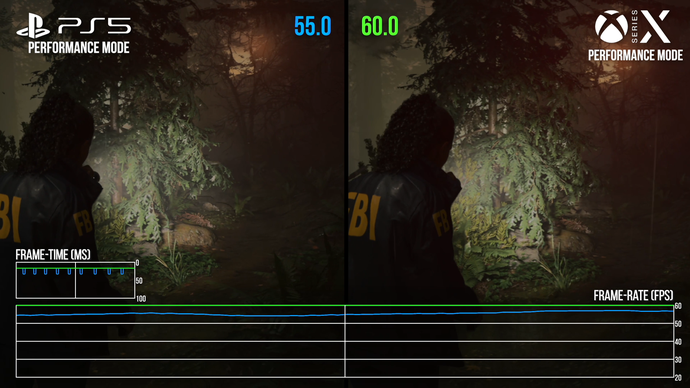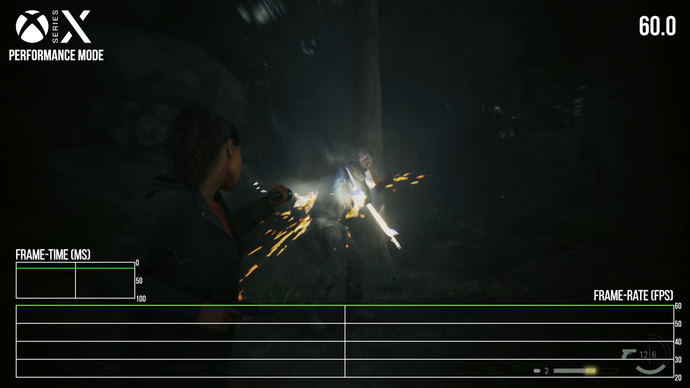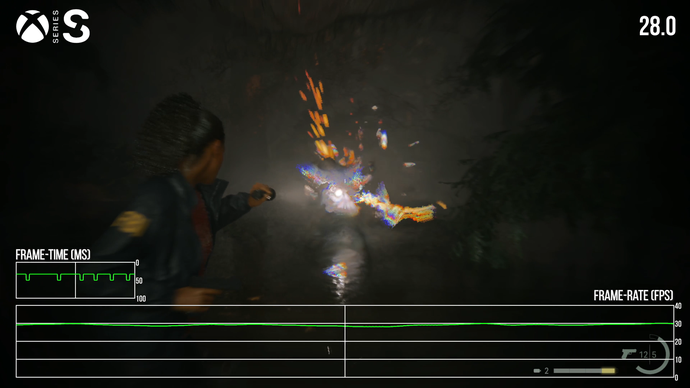Alan Wake 2 is one of the best-looking video games ever made. With beautiful lighting and intricate asset detail, it's a bit of a technical showcase, especially on PC with path tracing enabled. The PS5 release also looks brilliant, as I covered last week, with the similar visuals bereft of some path-tracing niceties and with some image quality issues. However, I didn't spend a huge amount of time looking at the differences between quality and performance modes. Meanwhile, review code for Xbox Series machines didn't arrive until launch, which raises a couple of key questions: does Series X match or improve upon PS5? Does Xbox Series S have the power to deliver a decent Alan Wake 2 experience?
On PS5 and Series X, Alan Wake offers a quality mode and a performance mode, which target 30 and 60 frames per second respectively. Remedy has gone a lot further than just tweaking resolution, however, with the developers cutting back a range of settings to hit the higher performance mode target, though most of these alterations are fairly subtle.
Most obviously, the density of environmental objects is decreased quite a lot in the performance mode. Plants that are present in the quality mode are often entirely absent when we switch to the performance mode. Grass also tends to see a reduction in density, with a more sparse, patchy appearance. Scattered leaves and rocks are similarly thinned out. Both modes look perfectly fine on their own terms, but the quality mode looks significantly more lush in head-to-heads, with abundant, thick foliage. While we're looking at the terrain, the performance mode also seems to have a slightly cruder terrain surface, with less obvious displacement for ground details. This is most obvious up close, where the ground clearly features less geometry than the quality mode.
Texture filtering takes a hit too and while most of the time it doesn't make a huge difference, distant texture detail in particular doesn't resolve well in the performance mode. The actual resolution of in-game textures is unchanged, however, as both resolve similar detail levels at close range. Volumetric lighting also encounters some obvious cutbacks and resolution is cut back somewhat to hit the harsher frame-time target. Fog quality is dialed down as well.
Next up is shadow quality. The performance mode's shadows are less comprehensive, so distant objects don't have shadows. Neither mode represents PC at its best, but the quality mode does have obviously better shadow coverage though overall resolution looks the same. Most of the difference in typical play comes down to shadow filtering, which operates at a higher quality level in the quality mode. Edges have a more defocused appearance, and shadows have a slightly smoother look, helping to minimise the appearance of aliasing.
There are a couple of other settings that have been changed as well. LOD settings are more aggressive in the performance mode, so pop-in is more intrusive and occurs closer to the player view. Global illumination takes a hit too, so certain details, like Saga's hair, showcase less accurate lighting in the performance mode. Screen-space reflections appear noticeably improved in the quality mode as well, with a less grainy and better-defined appearance, though this is just a byproduct of the differences in rendering resolution between the two modes.
In terms of resolution, the Series X version renders at 1270p in quality mode, with a 4K FSR 2 output resolution. In performance mode, we're looking at a 847p resolution, with an output of 1440p. This makes it a match for the PlayStation 5 version, which extends to visual quality generally. I couldn't find anything noteworthy to separate the visual feature set of these games: they effectively look the same, right down to the less-than-satisfactory artefacts from the FSR 2 upscaling pass.
Frame-rates are where the two systems diverge. Series X, for its part, delivers a very smooth rendition of Alan Wake. In performance mode, it offers close to a locked 60fps, with uncommon exceptions. We can drop a frame or two sometimes during traversal, and there are a few spots that cause momentary frame-rate drops, but the game feels quite smooth in general play. The consistency of the turnout here is surprising, and speaks to how scalable the game is on the GPU - and to how accommodating Alan Wake 2 can be towards lower-end CPU hardware. Quality mode is even more stable and per the embedded video above, I could only find one stand-out area where 30fps could not be met. Everywhere else, the game runs at a locked 30 frames per second with no deviations that I could see. Again, Alan Wake 2 is delivering great results, despite the highly advanced visual presentation.
PS5 doesn't fare quite as well. Certain areas really struggle in the performance mode, with an unstable feel in typical play in the affected areas. The frame-rate delta against the Series X is surprising, with the PS5 consistently failing to reach its frame-time target in some missions. The same is true in the quality mode. The PS5 is just running up against the 33.3ms frame budget in tougher areas like the second Saga Anderson mission. Performance is fine looking across the whole game, and most of the time the game does achieve its 30fps target, but the results are a more mixed than you'd typically expect from a 30fps current-gen game. The PS5's GPU is being pushed a little too hard here, without the necessary headroom to keep up in more difficult segments. In contrast, Series X has far fewer of these problems, though load times can be a few seconds longer.

Microsoft's junior current-gen console, the svelte Series S, tends to struggle with some of the more boundary-pushing pieces of current-gen software and while there are obvious drawbacks compared to the more powerful machines, it acquits itself fairly well overall. Alan Wake 2 runs with a 30fps target on Series S, with no option to engage a higher frame-rate mode. This is pretty common in Series S games, where high frame-rate options often impose an image quality penalty that is simply too large, at least when it comes to particularly demanding titles.
Beyond that concession, though, the Series S looks fine with visual settings similar to the Series X performance mode. Object density is about the same, while shadow quality is identical. Volumetric lights also appear to have the same rather limited resolution on Series S and Series X performance mode. Textures do throw up some differences, however. Most textures seem to be a complete match between the two machines here, but in the Mind Place, the case board textures clearly have a much lower resolution on Series S. The text in particular looks messy on the S, though the accompanying photographs also look less distinct. Screen-space reflections are also degraded a touch on the S. The static grain pattern seems slightly more prominent, and detail is muddier in the reflected image. I don't think that stems from a visual settings downgrade though, it's more likely to be a byproduct of a lower rendering resolution.
Internally, the Series S is operating at or around 720p. That's down from the 847p resolution in the Series X performance mode. Output resolution, though, remains at 1440p, as the two consoles exhibit very similar clarity in stills - and the rare snippet of UI that isn't anti-aliased comes in at a 1440p pixel count. When moving through the gameworld, it's easier to spot aliasing on the Series S version. Neither console is really covering itself in glory here, but I'd prefer the Series X image overall.


Performance-wise, the Series S manages a pretty stable 30fps with an update that is a bit more consistent than PS5 but falls slightly short of its more powerful sibling. There are some occasional moments in tougher areas where it can drop frames, though it tends to be well-behaved elsewhere. For a cut-price console, I think the Series S is delivering a perfectly fine update here, and the excellent motion blur and slower-paced gameplay render the lack of a 60fps option less of an issue than it would be in many other titles.
The premier Alan Wake experience is undoubtedly on the PC platform. With frankly incredible path-traced lighting, excellent image quality courtesy of DLSS, and the potential for high frame-rates, it comprehensively bests the console code. However, the consoles still look excellent in their own right, with top-class visuals even if PC's most lush finery is absent.
For those players who are looking for a good experience on consoles, I think all systems do a reasonable enough job. The performance and quality modes on the premium current-gen machines are also well calibrated, with the performance option looking great despite the halved frame-time target. However, the Series X has a notable performance advantage, running a good deal faster than the PS5 in taxing scenarios, making it the console of choice for now.


All consoles do exhibit certain issues though, to a greater or lesser degree. Shadows suffer from considerable aliasing and are low-resolution except at very close range. Screen-space reflections exhibit all their typical issues with occlusion, and have a grainy appearance that doesn't look very pleasing.
Additionally, image quality is questionable at times, with the performance modes and Series S most badly affected, which likely stems from aggressive upsampling targets combined with challenging visual content. The game does suffer from some bugs as well, including some cutscene audio sync errors on the Xbox versions, so it may be worth holding off for a while until patches are deployed.
In summary though, I'd say that Alan Wake 2 is a great experience on all console systems. This is a real visual accomplishment, delivering well-calibrated graphics even on Xbox Series S. There's still room for improvement, and the PS5 some work to more consistently achieve its performance target, but it's a truly impressive game that Digital Foundry recommends without hesitation.
- SEO Powered Content & PR Distribution. Get Amplified Today.
- PlatoData.Network Vertical Generative Ai. Empower Yourself. Access Here.
- PlatoAiStream. Web3 Intelligence. Knowledge Amplified. Access Here.
- PlatoESG. Carbon, CleanTech, Energy, Environment, Solar, Waste Management. Access Here.
- PlatoHealth. Biotech and Clinical Trials Intelligence. Access Here.
- Source: https://www.eurogamer.net/digitalfoundry-2023-alan-wake-2-runs-great-on-xbox-series-x-and-the-cut-backs-are-fine-on-series-s
- :has
- :is
- :not
- :where
- $UP
- 30
- 33
- 4k
- 60
- 7
- a
- About
- above
- absent
- abundant
- accurate
- Achieve
- across
- actual
- adhering
- advanced
- ADvantage
- affected
- again
- against
- aggressive
- Alan
- All
- also
- amount
- an
- and
- anderson
- anything
- appear
- ARE
- AREA
- areas
- around
- AS
- asset
- At
- audio
- back
- badly
- BE
- beautiful
- been
- being
- BEST
- Better
- between
- Beyond
- Bit
- blur
- board
- both
- Breakdown
- brilliant
- budget
- bugs
- but
- CAN
- case
- Cause
- certain
- challenging
- changed
- choice
- clarity
- clearly
- Close
- closer
- code
- combined
- comes
- Common
- compared
- complete
- comprehensive
- considerable
- consistent
- consistently
- Console
- consoles
- content
- contrast
- cookie
- cookies
- could
- couldn
- Couple
- coverage
- covered
- covering
- CPU
- Cut
- cutting
- deal
- decent
- decreased
- Degree
- deliver
- delivering
- delivers
- Delta
- demanding
- density
- deployed
- Despite
- detail
- details
- developers
- didn
- difference
- differences
- difficult
- digital
- displacement
- Distant
- distinct
- Diverge
- do
- does
- doesn
- don
- down
- Downgrade
- drawbacks
- Drop
- Dropping
- Drops
- during
- easier
- effectively
- else
- elsewhere
- embedded
- enable
- enabled
- engage
- enough
- entirely
- environmental
- Errors
- especially
- Even
- EVER
- everywhere
- example
- excellent
- Except
- exhibit
- expect
- experience
- extends
- failing
- fairly
- Falls
- far
- faster
- Feature
- Features
- feel
- few
- fewer
- filtering
- Find
- fine
- Fog
- For
- Foundry
- FRAME
- from
- further
- game
- gameplay
- Games
- GDPR
- General
- generally
- geometry
- get
- Global
- glory
- Go
- gone
- good
- GPU
- graphics
- grass
- great
- greater
- Ground
- Group
- Hair
- halved
- Hard
- Hardware
- harsher
- Have
- headroom
- helping
- here
- High
- higher
- highly
- Hit
- Hits
- holding
- holds
- How
- However
- HTTPS
- huge
- i
- identical
- if
- image
- impose
- impressive
- improve
- improved
- improvement
- improves
- in
- in-game
- Including
- incredible
- internally
- intricate
- isn
- issue
- issues
- IT
- ITS
- itself
- Job
- just
- Keep
- Key
- Lack
- large
- Last
- launch
- least
- left
- less
- lesser
- Level
- levels
- Lighting
- like
- likely
- Limited
- little
- load
- locked
- longer
- Look
- looking
- LOOKS
- Lot
- lower
- Machines
- made
- make
- MAKES
- Making
- manage
- manages
- many
- Match
- May..
- Meanwhile
- message
- met
- Microsoft
- mind
- minimise
- Mission
- missions
- mixed
- Mode
- modes
- Moments
- more
- most
- motion
- moving
- much
- necessary
- Neither
- next
- no
- notable
- noteworthy
- noticeably
- now
- object
- objects
- obvious
- occasional
- of
- off
- Offers
- often
- on
- ONE
- only
- operates
- operating
- Option
- Options
- or
- Other
- our
- out
- output
- overall
- own
- part
- particular
- particularly
- pass
- Patches
- path
- Pattern
- PC
- per
- perfectly
- performance
- photographs
- pieces
- Pixel
- Place
- plants
- platform
- plato
- Plato Data Intelligence
- PlatoData
- Play
- player
- players
- playstation
- PlayStation 5
- please
- potential
- power
- powerful
- prefer
- premier
- Premium
- present
- presentation
- pretty
- problems
- prominent
- PS5
- pushed
- quality
- Questions
- quite
- raises
- range
- RARE
- rather
- RE
- reach
- real
- really
- reasonable
- recommends
- reduction
- reflected
- Reflections
- release
- remains
- rendering
- renders
- represents
- Resolution
- respectively
- Results
- review
- right
- Room
- running
- runs
- s
- saga
- same
- say
- scalable
- scattered
- scenarios
- Second
- seconds
- see
- seem
- seems
- segments
- separate
- Series
- SERIES X
- set
- settings
- Shadow
- Short
- shot
- showcase
- significantly
- similar
- Similarly
- simply
- smooth
- smoother
- Snippet
- So
- Software
- some
- sometimes
- somewhat
- Speaks
- spend
- Spot
- spots
- stable
- stems
- Still
- Struggle
- SUMMARY
- Surface
- surprising
- Switch
- Systems
- T
- takes
- Target
- targeting
- targets
- Technical
- tends
- terms
- tests
- text
- than
- that
- The
- their
- There.
- These
- they
- think
- this
- those
- though?
- Through
- time
- times
- titles
- to
- too
- touch
- towards
- Tracing
- true
- truly
- tweaking
- two
- typical
- typically
- ui
- Uncommon
- undoubtedly
- until
- Update
- upon
- version
- very
- Video
- video games
- View
- visuals
- volumetric
- Wake
- we
- week
- WELL
- when
- which
- while
- WHO
- whole
- window
- with
- without
- Work
- worth
- would
- X
- xbox
- xbox series
- Xbox Series S
- Xbox Series X
- you
- youtube
- zephyrnet











